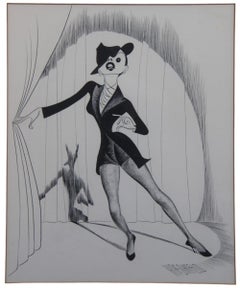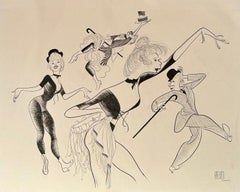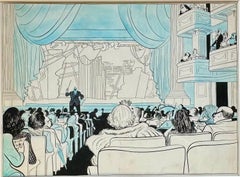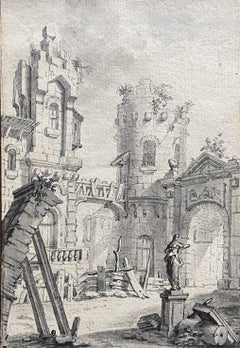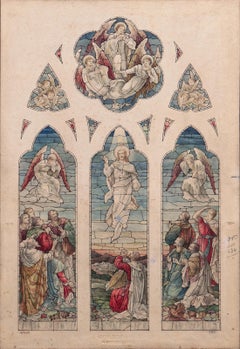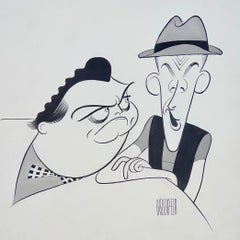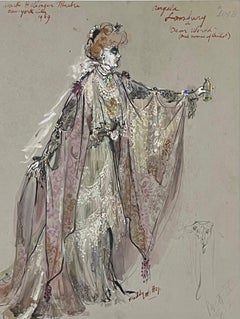Performance Figurative Drawings and Watercolors
to
1
9
9
Overall Width
to
Overall Height
to
19
2
2
8
1
2
3
1
5,168
3,454
588
360
250
246
240
212
168
157
48
48
42
26
10
8
1
14
13
11
6
4
3
2
2
2
2
1
1
1
1
1
1
1
14
12
5
4
4
10
1
15
3
19
Style: Performance
Original Judy Garland Get Happy Drawing. Legendary Star. Caricature. Not a Litho
Located in New York, NY
Original Judy Garland Get Happy Drawing. Legendary Star. Caricature. Not a Litho.
Al Hirshfeld (1903-2003)
Judy "All Star Variety" Garland at the Palace
Ink on board, 1955
Sight: 16...
Category
1950s Performance Figurative Drawings and Watercolors
Materials
Ink, Board
Gwen Verdon "Redhead" Original Caricature Drawing NY Times Published Tony Awards
Located in New York, NY
Gwen Verdon "Redhead" Original Caricature Drawing NY Times Published Tony Awards
Al Hirschfeld (1903 – 2003)
Gwen Verdon in "Redhead"
Sight: 14 1/2 x 19 inches
Ink on board
Signed l...
Category
1950s Performance Figurative Drawings and Watercolors
Materials
Board, Ink
"At Home Abroad" 1935 Broadway Play NY Times Published Illustration 20th Century
Located in New York, NY
"At Home Abroad" 1935 Broadway Play NY Times Published Illustration 20th Century
Al Hirschfeld (1903 - 2003)
At Home Abroad
9 1/2 x 17 inches (sight)
Ink on board
Signed upper right...
Category
1930s Performance Figurative Drawings and Watercolors
Materials
Ink, Board
"Judy Garland" Legendary Film and Recording Star. Gay Icon. 20th Century Litho
Located in New York, NY
"Judy Garland" Legendary Film and Recording Star. Gay Icon. 20th Century Litho
Al Hirschfeld (1903 - 2003)
Judy Garland
20 x 15 inches (sight)
Etching
26 1/2 x 14 3/4 inches Framed...
Category
1970s Performance Figurative Drawings and Watercolors
Materials
Ink, Board
"Let's Make an Opera" Original Drawing NYT Published, Norman Del Mar Conducts
Located in New York, NY
"Let's Make an Opera" Original Drawing NYT Published, Norman Del Mar Conducts
Al Hirschfeld (1903-2003)
"Let's Make An Opera"
Ink on board
13 1/2 x 18 1/2, sight
Framed: 22 1/2 x 27...
Category
1950s Performance Figurative Drawings and Watercolors
Materials
Ink, Board
Original TV Guide Illustration Caricature Esther Williams John Raitt Dinah Shore
Located in New York, NY
Original TV Guide Illustration Caricature Esther Williams John Raitt Dinah Shore. Published December 25, 1957 in TV Guide as an editorial to promote the Di...
Category
1950s Performance Figurative Drawings and Watercolors
Materials
Ink, Board
"King & I" Orig 1951 Broadway Drawing Published NYT Tony Awards Mid 20th Century
Located in New York, NY
"King & I" Orig 1951 Broadway Drawing Published NYT Tony Awards Mid 20th Century
Al Hirschfeld (1903 – 2003) "The King and I," 14 3/4 x 30 inches. Ink on board. Signed lower right. ...
Category
1950s Performance Figurative Drawings and Watercolors
Materials
Ink, Board
Bette Midler Legendary Film and Recording Star. Gay Icon. 20th Century Litho
Located in New York, NY
Bette Midler Legendary Film and Recording Star. Gay Icon. 20th Century Litho
Al Hirschfeld (1903 - 2003)
Bette Midler
15 x 11 inches (sight)
Etching
22 x 18 inches Framed
Signed an...
Category
1980s Performance Figurative Drawings and Watercolors
Materials
Ink, Board
"My Fair Lady" 1958 West End Theatre Costume Drawing Mid 20th Century Modern
By Cecil Beaton
Located in New York, NY
"My Fair Lady" 1958 West End Theatre Costume Drawing Mid 20th Century Modern
Cecil Beaton (1904 – 1980) "My Fair Lady," Pen and ink on paper. ...
Category
1950s Performance Figurative Drawings and Watercolors
Materials
Paper, Ink, Pen
Beverly Sills Opera Singer Diva Classical Music Grammys Caricature 20th Century
Located in New York, NY
Beverly Sills Opera Singer Diva Classical Music Grammys Caricature 20th Century
Al Hirschfeld (1903-2003)
Beverly Sills
Lithograph on heavy paper, 1983
Sight: 11 1/2 x 14 inches
Sig...
Category
1980s Performance Figurative Drawings and Watercolors
Materials
Lithograph
Ethel Merman "Annie Get Your Gun" original Mid Century Broadway theatre drawing
Located in New York, NY
Ethel Merman "Annie Get Your Gun" original Mid Century Broadway theatre drawing
Ethel Merman in the pre-Broadway tour of ANNIE GET YOUR GUN, 18 ½ ...
Category
1940s Performance Figurative Drawings and Watercolors
Materials
Ink, Watercolor, Board
Ann Miller in Follies Broadway Musical Contemporary Drawing Illustration Eloise
Located in New York, NY
Ann Miller in Follies Broadway Musical Contemporary Drawing Illustration Eloise
Ann Miller in Stephen Sondheim's "Follies." The 1998 production, played at the Papermill Playhouse. Affixed to the back of the drawing is a brochure promoting the show. Mixed media on paper. Signed lower left. Inscribed lower right: "Ann Miller at 75 'I'm Still Here' in Stephen Sondheim's 'Follies' 1998." Framed. 17 x 12 in. (sight). 22 1/2 x 17 1/2 in. (frame)
'Tops in Taps' Ann Miller was still going strong at 75 years old when she made her last appearance in the musical, "Follies." She was one of M.G.M's most prolific dancers and considered by many to be the greatest female tap dancer of all time.
Hilary, a friend of many years, is still going strong at 96. We saw this production at the Papermill Playhouse. Years ago, I was a press agent working in Henry Luhrman's office where we represented "Sugar Babies" with Ann Miller and Mickey Rooney.
Bio
Hilary Knight (born November 1, 1926) is an American writer-artist who is the illustrator of more than 50 books and the author of nine books. He is best known as the illustrator of Kay Thompson's Eloise (1955) and others in the Eloise series.
Knight has illustrated for a wide variety of clients, creating artwork for magazines, children's fashion advertisements, greeting cards, record albums and posters for Broadway musicals, including Gypsy, Irene, Half A Sixpence, Hallelujah Baby! and No, No Nanette.
The son of artist-writers Clayton Knight...
Category
1990s Performance Figurative Drawings and Watercolors
Materials
Paper, Mixed Media
Katharine Hepburn & Spencer Tracy WOMAN OF THE YEAR Oscars Classic Movie Film
Located in New York, NY
Katharine Hepburn & Spencer Tracy WOMAN OF THE YEAR Oscars Film NYT Published
Al Hirschfeld (1903-2003)
Katharine Hepburn and Spencer Tracy in "Woman of the Year"
Lithograph on hea...
Category
1980s Performance Figurative Drawings and Watercolors
Materials
Lithograph
"Cat on a Hot Tin Roof" Original Broadway Set Design Mid 20th Century American
By Jo Mielziner
Located in New York, NY
Jo Mielziner (1901 – 1976) "Cat on a Hot Tin Roof," 7 ½ x 11 ½ inches. Pencil on paper. Label verso from Richard Stoddard, Dated June 18. 1996. Mr. Joe W...
Category
1950s Performance Figurative Drawings and Watercolors
Materials
Paper, Pencil
Morris Carnovsky "Counterattack" 1943 Broadway Play Theatre Caricature Drawing
Located in New York, NY
Sam Norkin's original illustration for COUNTERATTACK, 1943, featuring Morris Carnovsky; ink on paper, dimensions: 19 ¾” x 15 ½”. Unframed.
Samuel Norkin (1917-2011) was a Brooklyn, New York-born cartoonist who specialized in theatre caricatures for more than seven decades. His drawings of theatre, opera, ballet and film celebrities appeared in Variety, Backstage, The Philadelphia Enquirer, The Washington Post, Los Angeles Times, The Boston Globe and many other publications. Norkin learned composition and anatomy from the muralist Mordi Gassner...
Category
1940s Performance Figurative Drawings and Watercolors
Materials
Ink, Board
Meryl Streep John Lithgow "Secret Service" 1976 Off Broadway Theatre Caricature
Located in New York, NY
Meryl Streep, John Lithgow and others starred in the Phoenix Theatre Company's Off-Broadway production of "Secret Service." This original 14 x 29 inch drawing by Sam Norkin was published in the New York Daily news on April 11, 1976.
Samuel Norkin (1917-2011) was a Brooklyn, New York-born cartoonist who specialized in theatre caricatures for more than seven decades. His drawings of theatre, opera, ballet and film celebrities appeared in Variety, Backstage, The Philadelphia Enquirer, The Washington Post, Los Angeles Times, The Boston Globe and many other publications. Norkin learned composition and anatomy from the muralist Mordi Gassner...
Category
1970s Performance Figurative Drawings and Watercolors
Materials
Ink, Gouache, Board
"Daughters of Atreus" Broadway Play Set Design Drawing American Modernism WPA
By Jo Mielziner
Located in New York, NY
"Daughters of Atreus" Broadway Play Set Design Drawing American Modernism WPA. 8 x 10 ¾ inches. Graphite on paper, 1936. Initialed on lower right. The play opens October 14, 1936 at Broadway’s 44th Street Theatre.
Handwritten title, date, and signature on lower center of original matte which is now affixed to the verso. Inscription on lower right of matte reads, "For Prince & Barbara - Jo Mielziner...
Category
1930s Performance Figurative Drawings and Watercolors
Materials
Paper, Graphite
Bless You All Tony Award Broadway Costume Design Mid 20th Century Theatre Modern
Located in New York, NY
Bless You All Tony Award Broadway Costume Design Mid 20th Century Theatre Modern.
Miles White (1915 – 2000) "Bless You All," 15 x 11 (sight) inches. Mixed media on paper. The musical opened December 13, 1950 at the Mark Hellinger Theatre. Miles won the 1951 Tony Award for Costume Design.
Miles was one of my closest friends for the last 20 years of his life. We live with one of his two Tony Awards and a dozen drawings.
BIO
White was a top Broadway and Hollywood costume designer. The artist created the costumes for the original Broadway productions of OKLAHOMA, CAROUSEL, PAL JOEY and BYE BYE BIRDIE...
Category
1950s Performance Figurative Drawings and Watercolors
Materials
Paper, Ink, Watercolor, Gouache
Liza Minnelli "Flora the Red Menace" Off Broadway Musical Theatrical Caricature
Located in New York, NY
Sam Norkin's original caricature of Liza Minnelli in "FLORA THE RED MENACE" Off Broadway Musical Theatrical Caricature. Published in the NY Daily News on May 9, 1965. Ink and gouache on board; dimensions: 23" x 15 1/4. Framed
Samuel Norkin (1917-2011) was a Brooklyn, New York-born cartoonist who specialized in theatre caricatures for more than seven decades. His drawings of theatre, opera, ballet and film celebrities appeared in Variety, Backstage, The Philadelphia Enquirer, The Washington Post, Los Angeles Times, The Boston Globe and many other publications. Norkin learned composition and anatomy from the muralist Mordi Gassner...
Category
1960s Performance Figurative Drawings and Watercolors
Materials
Ink, Gouache, Board
Related Items
18th Century School, Courtyard of a palazzo, Architectural Capriccio, drawing
Located in Paris, FR
18th Century french School,
Courtyard of a ruined palazzo, An Architectural Capriccio,
Pen and black ink and black ink wash on paper
17 x 12 cm
In good condition
Framed : 32 x 26 c...
Category
1780s Performance Figurative Drawings and Watercolors
Materials
Ink
$455 Sale Price
20% Off
H 6.7 in W 4.73 in
'Study for a Stained Glass Window', Devotional, Ecclesiastical, Pre-Raphaelite
Located in Santa Cruz, CA
A sensitively drawn and highly-detailed study for a three-panel set of stained glass windows showing the ascension of Jesus by angels and mortals.
Initialed, lower right, 'EB-J', an...
Category
1920s Performance Figurative Drawings and Watercolors
Materials
Ink, Watercolor, Gouache
Head of Medusa
Located in Indianapolis, IN
Titled and signed lower center and right.
Category
20th Century Performance Figurative Drawings and Watercolors
Materials
Clay, India Ink, Board
Church Interior
By Ray Quigley
Located in Buffalo, NY
A modern illustration by American artist Ray Quigley depicting two men inside of a church.
Category
1950s Performance Figurative Drawings and Watercolors
Materials
Gouache, Illustration Board, Ink
Life Magazine Story Illustration
Located in Fort Washington, PA
Medium: Pen and Ink on Board
Signature: Signed Lower Left
Story Illustration- Life Magazine ca. 1915
Seated Man in dressing gown pulling on maid's apron
Category
1910s Performance Figurative Drawings and Watercolors
Materials
Ink, Board, Pen
In the Art Gallery, Early 20th Century Watercolor, Women Viewing Painting
Located in Beachwood, OH
Jules Andre Smith (American, 1880-1959)
In the Art Gallery, 1936
Watercolor and pen and ink
Signed Andre Smith, 1936 lower right
10.75 x 8.5 inches
20.25 x 17.25 inches, framed
Jule...
Category
1930s Performance Figurative Drawings and Watercolors
Materials
Pen, Ink, Watercolor
$850
H 20.25 in W 17.25 in
Louis Bouché, (Standing Woman)
By Louis Bouché
Located in New York, NY
Louis Bouché was based in New York and taught at the Art Students League. The figure was an important subject in his oeuvre. An ink drawing on tan paper, ...
Category
Early 20th Century Performance Figurative Drawings and Watercolors
Materials
Ink
Cuban Artist - Caricature of Adolphe Menjou Debonair Devil
Located in Miami, FL
Framed Cuban Artist/Caricaturist Conrado Walter Massaguer presents Hollywood star Adolphe Menjou in a satirical dual portrait. In the foreground, the subject is seen in a dapper top hat, tux, fashionable cigarette and boutonnière, and is shown as being the epitome of being stylishly debonair. To make a larger point about this subject, Massaguer paints a cast shadow of Menjou as a burning red devil who studies his alter ego from above. Keeping with the artist's sarcasm, we see the good and bad in one image. Works by Massaguer are rare and this work is in keeping with his signature style. This work was most likely done on assignment for Life Magazine, Cosmopolitan, The New Yorker or Vanity Fair. Signed upper right. Inscribe lower right. Titled on verso. Unframed, Slight bend to board; toning to board; scattered faint foxing; pin point abrasions to margins, not affecting image. 19-1/2 x 15-1/8 inches board size.
Conrado Walter Massaguer y Diaz was a Cuban artist, political satirist, and magazine publisher. He is considered a student of the Art Nouveau. He was the first caricaturist in the world to broadcast his art on television.He was first caricaturist to exhibit on Fifth Avenue. He was the first caricaturist in the world to exhibit his caricatures on wood. He, and his brother Oscar, were the first magazine publishers in the world to use photolithographic printing.
Self portrait of Conrado Walter Massaguer, depicted on a carrousel ride, with the devil over his left shoulder and an angel over his right. (1945)
He created the magazine Social with his brother Oscar to showcase Cuban artistic talent. The duo later created the magazine Carteles, which became for a period the most popular magazine in Cuba, which was purchased by Miguel Ángel Quevedo in 1953.
In his life, he met and drew caricatures of Franklin D. Roosevelt, Walt Disney, Albert Einstein, the King of Spain, and many others.[ In sum total, he was the author of more than 28 thousand caricatures and drawings.Ernest Hemingway once had to refrain himself from punching Massaguer in the face after the artist drew an unflattering caricature of him. The dictator Gerardo Machado, however, did not punch Massaguer for his own unflattering caricature - he had the artist deported.
He was one of the most internationally renowned Cuban artists of his day, and his art is still regularly featured in galleries across the Western Hemisphere and Europe.
Early life
Massaguer was born on October 18, 1889, in Cárdenas, Cuba.[In 1892, his family moved to Havana.
When the Cuban War of Independence broke out, Massaguer's family escaped the country. From 1896 to 1908, he lived in Mérida, Mexico. However, during this time, his parents enrolled him in the New York Military Academy, where he stayed during school years.
In 1905, after graduating the military academy, he briefly attended the San Fernando school in Havana, where he was tutored by Ricardo de la Torriente and Leopoldo Romañach.
In 1906, less than a year later, he returned to the family home in Mexico.
Career as artist
Early career
While living in Yucatán, Mexico, Massaguer published his first caricatures in local newspapers and magazines. These included La Campana, La Arcadia, and the Diario Yucateco.
In 1908, he moved back to Havana. After returning to the island in 1908, Massaguer began mingling with Havana's aristocratic circles, forming close friendships with some of the city's most powerful and influential men, as well as winning the favor of many women who were quickly charmed by him. Massaguer, largely self-taught, honed his style using the avant-garde techniques he studied from the European and American magazines that were widely available in Cuba at the time.
Cover of the immensely popular Cuban magazine El Figaro, drawn by Massaguer in 1909. This cover depicts two bumbling, incompetent American tourists to the island.
He started drawing for El Fígaro, and was featured prominently on the cover in 1909.
After two years of refining his craft, Havana announced a poster contest aimed at attracting North American tourists to stay in the city during the winter months. Notable figures like Leopoldo Romañach, Armando Menocal, Rodríguez Morey, Jaime Valls, and others also entered the competition. The jury was particularly impressed by the modern execution and creative solution of one piece, signed by Massaguer, who was relatively unknown at the time.
The jury deliberations caused a great controversy.[5] The prize was ultimately awarded to the Galician painter Mariano Miguel, who had recently married the daughter of Nicolás Rivero, the wealthy owner of the conservative newspaper Diario de la Marina. Although Massaguer received only an honorable mention, the fraud scandal caused such an uproar that his name quickly entered the public spotlight, and he became an overnight sensation.
In 1910, he became co-owner of the advertising agency Mercurio, with Laureano Rodríguez Castells. At Mercurio, he led the Susini cigar campaign, and earned substantial wealth.
Massaguer has been described as a restless man, in both mind and body.After earning enough money from his art to begin traveling, he was almost always doing so. He constantly traveled between New York City and Havana, Mexico and France, Europe and the Americas.
In 1911, his reputation among the Havana socialites solidified when he organized his own first public caricature exhibit, and also the first Caricature Salon ever held in the Americas, hosted at Athenaeum of Havana (the Ateneo), and the Círculo de La Habana. Other exhibitors here included Maribona, Riverón, Portell Vilá, Valer, Botet, Barsó, García Cabrera, Carlos Fernández, Rafael Blanco, and Hamilton de Grau.
"Messaguer Visits Broadway." Caricatures of theatrical and literary figures. Elsie Janis, Raymond Hitchcock, S. Jay Kaufman (columnist), Ibanez, author of The Four Horsemen, and Frances White
In 1912, in the New York American Journal, he published his first Broadway drawings.
From 1913 to 1918, he was an editor for Gráfico.
Social
Main article: Social (magazine)
Cover of the magazine Social, July 7, 1923
In 1916, he created the magazine Social with his brother, Oscar H. Massaguer. Social's contributors included Guillén Carpentier, Chacón y Calvo, Enrique José Varona and others.Social has been described as Massaguer's great love in the magazine industry, and was the property that historians say he cared the most about. Social was an innovative magazine, being the first magazine in the world to use a modern printing process called photolithographic printing.
Social set cultural trends, not only in the fashion of Cuba, but in art, politics, and Cuban identity.[11] Social catered to a certain aesthetic in Cuba - that of the sophisticated elite socialite - but Massaguer would also use this magazine to ridicule and jibe against that same class of society when he found their personalities worthy of his contempt.
In Social, readers could find a variety of content, including short stories, avant-garde poetry, art reviews, philosophical essays, and serialized novels, as well as articles on interior design, haute couture, and fashion. Occasionally, the magazine also featured reports on sports such as motor racing, rowing, tennis, and horse riding.The cultural promotion efforts of both Massaguer and Emilio Roig de Leuchsenring are evident in the magazine. Notably, this period overlaps with their involvement in the Minorista Group, which was then at the forefront of the country's intellectual life.[5] Many contributors were devoted members of the group, leading some experts to consider Social as the cultural voice of the Minoristas.
One of the features of Social magazine was its section called "Massa Girls," which was a play on his own name, and pronounced with a glottal 'g' in a similar fashion to the letter in Massaguer.[12] Massaguer drew women as independent and free-thinking, and never drew the woman celebrity as a caricature of herself, but as a free agent surrounded by caricatures.[11] However, Massaguer himself has been described as a womanizer in his personal life, and hesitant to fully embrace every facet of women's liberation.
In 1916, he also established la Unión de Artes Gráficas and the advertising agency Kesevén Anuncios.[9]
The art critic Bernardo González Barroa wrote:
“Massaguer has solved the problem of working hard, living comfortably off what his art produces and not missing any artistic, sporting or social event. His broad, childish laugh, of a carefree individual who carries his luck hidden in a pocket, appears everywhere for the moment, disguising the pranks of pupils that lurk, mock and, finally, flash with satisfaction at finding the characteristic point after having analyzed a soul... Massaguer's personality is beginning to solidify now. He has been the best-known and most popular caricaturist for a long time, but his technique had not reached the security, the mastery of values that he presents in his latest works, which is very natural and explainable”[5]
Carteles
Main article: Carteles
Cover of the magazine Carteles, November 29, 1931
In 1919, Massaguer and his brother created the magazine Carteles.[9] Carteles gained the widest circulation of any magazine in Latin America, and the most popular magazine in Cuba for a time, until that title was claimed by Revista Bohemia. Carteles remained in print until July 1960.This magazine showcased Cuban commerce, art, sports, and social life before the revolution.
In 1924, Carteles took a more political turn, with articles criticizing Gerardo Machado's government. it became a prime example of the humor and graphic design employed by artists like Horacio Rodríguez Suria and Andrés García...
Category
1930s Performance Figurative Drawings and Watercolors
Materials
Watercolor, Ink, Illustration Board
$12,500
H 16.38 in W 12.5 in
Louis Tinayre (1861-1942) An encampment of journalists, signed drawing
Located in Paris, FR
Louis Tinayre (1861-1942)
An encampment of journalists in Chambéry,
signed and titled lower left "Campement de journalistes à Chambéry"
Ink on paper
In quite good condition, a a visible vertical fold in the centre, some stains and foxings
21 x 29 cm
Framed : 33.7 x 45.5 cm
Louis Tinayre's background and adventurous life obviously inform this humorous and detailed scene. He demonstrates a remarkable sense of observation, capturing this scene of extraordinary life like a journalistic illustrator.
A contributor, to whom I'd like to express my sincere thanks, sheds important light on the nature of this scene.
It appears that this drawing is the draft for an illustration published in “Le Monde illustré” of August 4, 1888 (page 77), to accompany the article “Épilogue du voyage présidentiel” (Epilogue to the presidential trip) - president Sadi Carnot- en Savoie et en Dauphiné (p. 74), which ends with: “As a picturesque note, we enclose an improvised journalists' dormitory in Chambéry, where our colleagues deeply regretted the comfort of the special train”.
As a quasi-ethnographic observer, Tinayre's interest lies in the journalists' camp, which he turns into a tender, comical scene. We understand him better when we know that he may have been similarly fascinated by the territories of Madagascar, the North Pole or the Far West that he painted and drew.
Louis Tinayre was born on 14 March 1861 in Neuilly-sur-Seine. His mother, Victoire Tinayre, was a teacher and a member of the International Workers' Association.
Louis was the son of a Communard couple. His father, Jean Joseph, known as Jules Tinayre (Issoire 1821 - Paris 1871) was shot during the Bloody Week. His mother, Victoire Tinayre, fled with her children. Louis was the first to be sent to Hungary, and the rest of the family (including his brother Julien) joined him there later. He studied Fine Arts at the Hungarian University of Fine Arts in Budapest.
Returning to Paris in 1880 (after the amnesty), Louis Tinayre assiduously frequented Le Chat noir, where he met the positivists and Adèle Jacomet (Buenos Aires 1867-1946), whom he married in 1888.
He became an animal painter and press illustrator and was sent by Le Monde Illustré to cover the second expedition to Madagascar (then under French protectorate) in 1895.
He stayed there, fascinated, for six months and produced numerous drawings and photographs. Back in France, he created eight 5 x 4 meters dioramas presented at the National and Colonial Exhibition in Rouen in 1896.
He returned to Madagascar in 1898 to prepare the creation of a giant panorama representing the surrender of Antananarivo in 1895. The Malagasy pavilion at the 1900 Universal Exhibition in Paris allowed him to admire the dioramas (on the ground floor) and the panorama (on the first floor).
On his second trip, Tinayre took a Lumière cinematograph with him to document the daily life of the Malagasy people, no doubt to facilitate the design of the vast panorama. These short films were donated to the Cinémathèque française in 2009 by his grandson, Alain Tinayre.
One of the admirers of Tinayre's drawings, watercolours, paintings and photographs at the Universal Exhibition was Prince Albert I of Monaco: from 1901 onwards, Tinayre accompanied him on his hunts, painting scenes in North Africa, Russia, the Far West (Wyoming) and the North Pole. Tinayre, the official painter of the Prince's scientific expeditions, left his name to a glacier.
Together with the painter Alexandre Jean-Baptiste Brun, he painted the four murals in the large amphitheatre of the Oceanographic Institute in Paris. Louis Tinayre painted the figures while Alexandre Brun...
Category
1890s Performance Figurative Drawings and Watercolors
Materials
Ink
$365 Sale Price
20% Off
H 8.27 in W 11.42 in
19th C. Newspaper Illustration of Hiram H. Hobbs, Foreman of the Grand Jury 1898
Located in Soquel, CA
Historical late 19th century portrait of Hiram H. Hobbs, Foreman of the Grand Jury of San Francisco y Richard Langtry Partington (American, ...
Category
1890s Performance Figurative Drawings and Watercolors
Materials
India Ink, Illustration Board
$636 Sale Price
20% Off
H 9 in W 7 in D 0.25 in
'Figural Interior', Paris, Académie Julian, Salon D’Automne, Benezit, Bordello
Located in Santa Cruz, CA
'Figural Interior' by André Dignimont.
Paris, Académie Julian, Salon D’Automne, Benezit, Bordello
----
Signed lower right, "Dignimont" for André Digni...
Category
1950s Performance Figurative Drawings and Watercolors
Materials
Paper, Ink, Watercolor, Gouache
Design for a theatre fresco with fancy plasterwork - early 18th century French S
Located in Middletown, NY
Pen and sepia ink on cream laid paper, 8 3/4 x 5 3/8 inches (222 x 136 mm). Scattered paper tape repairs on the verso in the area of the upper left corner, and along the right sheet...
Category
Early 18th Century Performance Figurative Drawings and Watercolors
Materials
Ink, Laid Paper
$300
H 8.75 in W 5.38 in
Previously Available Items
Honeymooners Classic TV Emmy Awards Caricature Jackie Gleason Art Carney Drawing
Located in New York, NY
Honeymooners Classic TV Emmy Awards Caricature Jackie Gleason Art Carney Drawing. Board size is 16 1/2 x 16 `1/2 inches.
Provenance:
Estate of Michael Lang...
Category
1980s Performance Figurative Drawings and Watercolors
Materials
Ink, Board
Angela Lansbury "Dear World" Original Broadway Costume Design Tony Awards 1960s
Located in New York, NY
Angela Lansbury "Dear World" Original Broadway Costume Design Tony Awards 1960s.
Sight size 19 1/2 x 14 1/4.
Provenance: Freddy Wittop Estate.
In addition to this "Dear World" drawing, the gallery is offering two other Wittop drawings, Carol Channing in the original "Hello Dolly!" red dress and Mary Tyler Moore as Holly Golightly from "Breakfast at Tiffanys."
BIO
Wittop was born in Bussum, the Netherlands, on July 26, 1911. Wittop moved with his family to Brussels where he apprenticed at 13 years of age with the resident designer at the Brussels Opera. Moving to Paris in 1931, Wittop designed for the Folies Bergere and other music halls, creating hundreds of costumes for chorus as well as stars Mistinguett and Josephine Baker. Wittop studied Spanish dance and in the 1930s began a professional dancing career in Paris that led to international acclaim as he and his first partner, the famed Argentinita appeared world-wide. He also toured with Pilar Gomez, Jose Greco, and Tina Ramirez.
Wittop started designing for the Ice Capades in 1942, the same year he created costumes for George Abbott's musical Beat the Band. By 1949 Wittop was desiging costumes for The Latin Quarter Night Club Revue. Harold Clurman's revival of Shaw's Heartbreak House with Maurice Evans brought Wittop significant acclaim and was followed by the successful Carnival with Jerry Orbach and Anna Maria Alberghetti, followed by Subways Are For Sleeping for David Merrick. In 1964, Wittop won the Tony Award for Best Costume Design for Hello Dolly, starring Carol Channing. Subsequently, he was nominated five additional times for Best Costume Design for The Roar of the Greasepaint, The Smell of the Crowd; I Do! I Do! with Mary Martin and Robert Preston; The Happy Time with Robert Goulet; A Patriot for Me; and Lovely Ladies, Kind Gentlemen.
After an eleven-year retirement in Ibiza off the coast of Spain, Wittop returned to New York City to design costumes for The Three Musketeers. Wittop retired again in 1986 to Tequesta, Florida, although he made frequent trips to Athens, Georgia, where he held a position as adjunct professor in the school of drama at the University of Georgia.
Mr. Wittop was chosen as the 2001 recipient of Theatre Development Fund's Irene Sharaff...
Category
1960s Performance Figurative Drawings and Watercolors
Materials
Paper, Ink, Watercolor, Gouache
Mary Tyler Moore "Breakfast at Tiffany's" Original Broadway Costume Design 1960s
Located in New York, NY
Mary Tyler Moore "Breakfast at Tiffany's" Original Broadway Costume Design 1960s
Sight size 19 1/2 x 15 inches.
Provenance: Freddy Wittip Estate.
In addition to this "Breakfast at Tiffany's" drawing, the gallery is offering two other Wittop drawings, Carol Channing in the original "Hello Dolly!" red dress and Angela Lansbury from "Dear World"
BIO
Wittop was born in Bussum, the Netherlands, on July 26, 1911. Wittop moved with his family to Brussels where he apprenticed at 13 years of age with the resident designer at the Brussels Opera. Moving to Paris in 1931, Wittop designed for the Folies Bergere and other music halls, creating hundreds of costumes for chorus as well as stars Mistinguett and Josephine Baker. Wittop studied Spanish dance and in the 1930s began a professional dancing career in Paris that led to international acclaim as he and his first partner, the famed Argentinita appeared world-wide. He also toured with Pilar Gomez, Jose Greco, and Tina Ramirez.
Wittop started designing for the Ice Capades in 1942, the same year he created costumes for George Abbott's musical Beat the Band. By 1949 Wittop was desiging costumes for The Latin Quarter Night Club Revue. Harold Clurman's revival of Shaw's Heartbreak House with Maurice Evans brought Wittop significant acclaim and was followed by the successful Carnival with Jerry Orbach and Anna Maria Alberghetti, followed by Subways Are For Sleeping for David Merrick. In 1964, Wittop won the Tony Award for Best Costume Design for Hello Dolly, starring Carol Channing. Subsequently, he was nominated five additional times for Best Costume Design for The Roar of the Greasepaint, The Smell of the Crowd; I Do! I Do! with Mary Martin and Robert Preston; The Happy Time with Robert Goulet; A Patriot for Me; and Lovely Ladies, Kind Gentlemen.
After an eleven-year retirement in Ibiza off the coast of Spain, Wittop returned to New York City to design costumes for The Three Musketeers. Wittop retired again in 1986 to Tequesta, Florida, although he made frequent trips to Athens, Georgia, where he held a position as adjunct professor in the school of drama at the University of Georgia.
Mr. Wittop was chosen as the 2001 recipient of Theatre Development Fund's Irene...
Category
1960s Performance Figurative Drawings and Watercolors
Materials
Paper, Ink, Watercolor, Gouache
Carol Channing "Hello Dolly!" Original Broadway Costume Drawing Tony Awards 1964
Located in New York, NY
Carol Channing "Hello Dolly!" Original Broadway Costume Drawing Tony Awards 1964.
Sight size 20 x 15 3/4. Signed lower right.
Provenance: Freddy Wittop Estate.
In addition to this iconic "Hello Dolly!" drawing, the gallery is offering two other Wittop drawings, Angela Lansbury in "Dear World" and Mary Tyler Moore as Holly Golightly from "Breakfast at Tiffanys."
BIO
Wittop was born in Bussum, the Netherlands, on July 26, 1911. Wittop moved with his family to Brussels where he apprenticed at 13 years of age with the resident designer at the Brussels Opera. Moving to Paris in 1931, Wittop designed for the Folies Bergere and other music halls, creating hundreds of costumes for chorus as well as stars Mistinguett and Josephine Baker. Wittop studied Spanish dance and in the 1930s began a professional dancing career in Paris that led to international acclaim as he and his first partner, the famed Argentinita appeared world-wide. He also toured with Pilar Gomez, Jose Greco, and Tina Ramirez.
Wittop started designing for the Ice Capades in 1942, the same year he created costumes for George Abbott's musical Beat the Band. By 1949 Wittop was desiging costumes for The Latin Quarter Night Club Revue. Harold Clurman's revival of Shaw's Heartbreak House with Maurice Evans brought Wittop significant acclaim and was followed by the successful Carnival with Jerry Orbach and Anna Maria Alberghetti, followed by Subways Are For Sleeping for David Merrick. In 1964, Wittop won the Tony Award for Best Costume Design for Hello Dolly, starring Carol Channing. Subsequently, he was nominated five additional times for Best Costume Design for The Roar of the Greasepaint, The Smell of the Crowd; I Do! I Do! with Mary Martin and Robert Preston; The Happy Time with Robert Goulet; A Patriot for Me; and Lovely Ladies, Kind Gentlemen.
After an eleven-year retirement in Ibiza off the coast of Spain, Wittop returned to New York City to design costumes for The Three Musketeers. Wittop retired again in 1986 to Tequesta, Florida, although he made frequent trips to Athens, Georgia, where he held a position as adjunct professor in the school of drama at the University of Georgia.
Mr. Wittop was chosen as the 2001 recipient of Theatre Development Fund's Irene Sharaff...
Category
1960s Performance Figurative Drawings and Watercolors
Materials
Paper, Ink, Watercolor, Gouache
Judy Garland Hollywood Film 1963 Costume Design Mid 20th Century Gay Icon Oscars
Located in New York, NY
Judy Garland Hollywood Film 1963 Costume Design Mid 20th Century Gay Icon Oscars
EDITH HEAD (1897-1981) Original costume design for the red dress worn by J...
Category
1960s Performance Figurative Drawings and Watercolors
Materials
Paper, Watercolor, Pencil
Larry Kert "I Can Get It For You Wholesale" Broadway tour Theatre Caricature
Located in New York, NY
Sam Norkin original charicature of Larry Kert in 'I CAN GET IT FOR YOU WHOLESALE" National tour, February 1963, gouache and ink on board, Dimensions: 19 1/4 x 22 inches. Unframed.
Samuel Norkin (1917-2011) was a Brooklyn, New York-born cartoonist who specialized in theatre caricatures for more than seven decades. His drawings of theatre, opera, ballet and film celebrities appeared in Variety, Backstage, The Philadelphia Enquirer, The Washington Post, Los Angeles Times, The Boston Globe and many other publications. Norkin learned composition and anatomy from the muralist Mordi Gassner...
Category
1960s Performance Figurative Drawings and Watercolors
Materials
Ink, Gouache, Board
Carol Channing "Gentlemen Prefer Blondes" Broadway Musical Theatrical Caricature
Located in New York, NY
Carol Channing "Gentlemen Prefer Blondes" Broadway Musical Theatrical Caricature. Samuel Norkin's original caricature. Pre-Broadway engagement, Boston, ...
Category
1940s Performance Figurative Drawings and Watercolors
Materials
Ink, Gouache, Board
Performance figurative drawings and watercolors for sale on 1stDibs.
Find a wide variety of authentic Performance figurative drawings and watercolors available for sale on 1stDibs. Works in this style were very popular during the 20th Century, but contemporary artists have continued to produce works inspired by this movement. If you’re looking to add figurative drawings and watercolors created in this style to introduce contrast in an otherwise neutral space in your home, the works available on 1stDibs include elements of blue and other colors. Many Pop art paintings were created by popular artists on 1stDibs, including Albert Al Hirschfeld, and Cecil Beaton. Frequently made by artists working with Ink, and Board and other materials, all of these pieces for sale are unique and have attracted attention over the years. Not every interior allows for large Performance figurative drawings and watercolors, so small editions measuring 14 inches across are also available. Prices for figurative drawings and watercolors made by famous or emerging artists can differ depending on medium, time period and other attributes. On 1stDibs, the price for these items starts at $950 and tops out at $75,000, while the average work sells for $12,500.
Recently Viewed
View AllMore Ways To Browse
Beatles Lithograph
Bernard Martin
Black And Tan Terrier
Borzoi Painting
Botanical Print California
British Empire Painting
Buddy Holly
Burford Painting
Burro Paintings
Capitola Painting
Cavalier Dog Painting
Chinese Tiger Painting
Christmas Deer
Churches In Russia
Claire Wiltshire
Clement Cycles
Conquistador Art
Constantinople Painting
